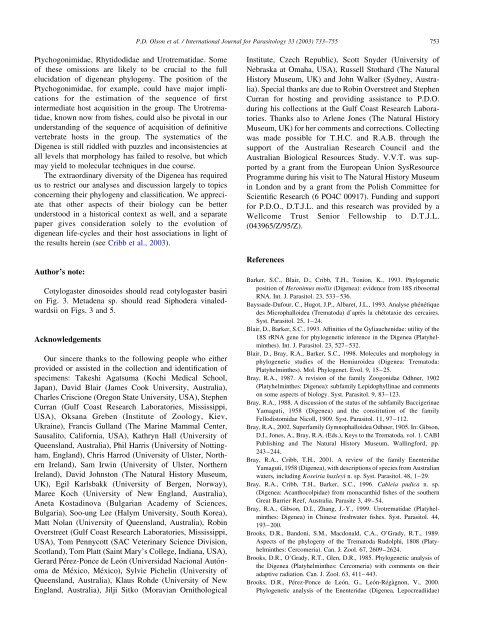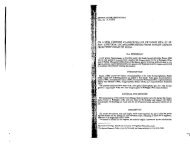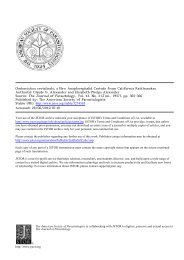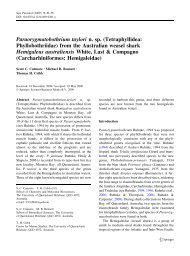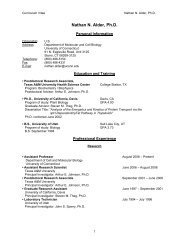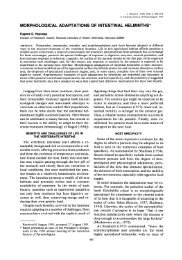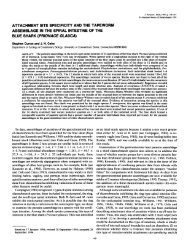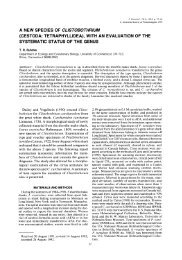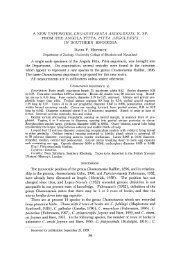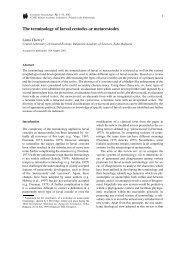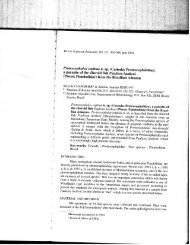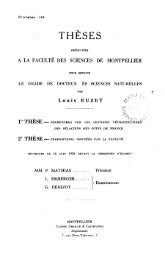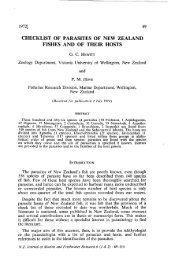Phylogeny and classification of the Digenea (Platyhelminthes ...
Phylogeny and classification of the Digenea (Platyhelminthes ...
Phylogeny and classification of the Digenea (Platyhelminthes ...
Create successful ePaper yourself
Turn your PDF publications into a flip-book with our unique Google optimized e-Paper software.
P.D. Olson et al. / International Journal for Parasitology 33 (2003) 733–755 753Ptychogonimidae, Rhytidodidae <strong>and</strong> Urotrematidae. Some<strong>of</strong> <strong>the</strong>se omissions are likely to be crucial to <strong>the</strong> fullelucidation <strong>of</strong> digenean phylogeny. The position <strong>of</strong> <strong>the</strong>Ptychogonimidae, for example, could have major implicationsfor <strong>the</strong> estimation <strong>of</strong> <strong>the</strong> sequence <strong>of</strong> firstintermediate host acquisition in <strong>the</strong> group. The Urotrematidae,known now from fishes, could also be pivotal in ourunderst<strong>and</strong>ing <strong>of</strong> <strong>the</strong> sequence <strong>of</strong> acquisition <strong>of</strong> definitivevertebrate hosts in <strong>the</strong> group. The systematics <strong>of</strong> <strong>the</strong><strong>Digenea</strong> is still riddled with puzzles <strong>and</strong> inconsistencies atall levels that morphology has failed to resolve, but whichmay yield to molecular techniques in due course.The extraordinary diversity <strong>of</strong> <strong>the</strong> <strong>Digenea</strong> has requiredus to restrict our analyses <strong>and</strong> discussion largely to topicsconcerning <strong>the</strong>ir phylogeny <strong>and</strong> <strong>classification</strong>. We appreciatethat o<strong>the</strong>r aspects <strong>of</strong> <strong>the</strong>ir biology can be betterunderstood in a historical context as well, <strong>and</strong> a separatepaper gives consideration solely to <strong>the</strong> evolution <strong>of</strong>digenean life-cycles <strong>and</strong> <strong>the</strong>ir host associations in light <strong>of</strong><strong>the</strong> results herein (see Cribb et al., 2003).Author’s note:Cotylogaster dinosoides should read cotylogaster basirion Fig. 3. Metadena sp. should read Siphodera vinaledwardsiion Figs. 3 <strong>and</strong> 5.AcknowledgementsOur sincere thanks to <strong>the</strong> following people who ei<strong>the</strong>rprovided or assisted in <strong>the</strong> collection <strong>and</strong> identification <strong>of</strong>specimens: Takeshi Agatsuma (Kochi Medical School,Japan), David Blair (James Cook University, Australia),Charles Criscione (Oregon State University, USA), StephenCurran (Gulf Coast Research Laboratories, Mississippi,USA), Oksana Greben (Institute <strong>of</strong> Zoology, Kiev,Ukraine), Francis Gull<strong>and</strong> (The Marine Mammal Center,Sausalito, California, USA), Kathryn Hall (University <strong>of</strong>Queensl<strong>and</strong>, Australia), Phil Harris (University <strong>of</strong> Nottingham,Engl<strong>and</strong>), Chris Harrod (University <strong>of</strong> Ulster, Nor<strong>the</strong>rnIrel<strong>and</strong>), Sam Irwin (University <strong>of</strong> Ulster, Nor<strong>the</strong>rnIrel<strong>and</strong>), David Johnston (The Natural History Museum,UK), Egil Karlsbakk (University <strong>of</strong> Bergen, Norway),Maree Koch (University <strong>of</strong> New Engl<strong>and</strong>, Australia),Aneta Kostadinova (Bulgarian Academy <strong>of</strong> Sciences,Bulgaria), Soo-ung Lee (Halym University, South Korea),Matt Nolan (University <strong>of</strong> Queensl<strong>and</strong>, Australia), RobinOverstreet (Gulf Coast Research Laboratories, Mississippi,USA), Tom Pennycott (SAC Veterinary Science Division,Scotl<strong>and</strong>), Tom Platt (Saint Mary’s College, Indiana, USA),Gerard Pérez-Ponce de León (Universidad Nacional Autónomade México, México), Sylvie Pichelin (University <strong>of</strong>Queensl<strong>and</strong>, Australia), Klaus Rohde (University <strong>of</strong> NewEngl<strong>and</strong>, Australia), Jilji Sitko (Moravian OrnithologicalInstitute, Czech Republic), Scott Snyder (University <strong>of</strong>Nebraska at Omaha, USA), Russell Stothard (The NaturalHistory Museum, UK) <strong>and</strong> John Walker (Sydney, Australia).Special thanks are due to Robin Overstreet <strong>and</strong> StephenCurran for hosting <strong>and</strong> providing assistance to P.D.O.during his collections at <strong>the</strong> Gulf Coast Research Laboratories.Thanks also to Arlene Jones (The Natural HistoryMuseum, UK) for her comments <strong>and</strong> corrections. Collectingwas made possible for T.H.C. <strong>and</strong> R.A.B. through <strong>the</strong>support <strong>of</strong> <strong>the</strong> Australian Research Council <strong>and</strong> <strong>the</strong>Australian Biological Resources Study. V.V.T. was supportedby a grant from <strong>the</strong> European Union SysResourceProgramme during his visit to The Natural History Museumin London <strong>and</strong> by a grant from <strong>the</strong> Polish Committee forScientific Research (6 PO4C 00917). Funding <strong>and</strong> supportfor P.D.O., D.T.J.L. <strong>and</strong> this research was provided by aWellcome Trust Senior Fellowship to D.T.J.L.(043965/Z/95/Z).ReferencesBarker, S.C., Blair, D., Cribb, T.H., Tonion, K., 1993. Phylogeneticposition <strong>of</strong> Heronimus mollis (<strong>Digenea</strong>): evidence from 18S ribosomalRNA. Int. J. Parasitol. 23, 533–536.Bayssade-Dufour, C., Hugot, J.P., Albaret, J.L., 1993. Analyse phénétiquedes Microphalloidea (Trematoda) d’après la chétotaxie des cercaires.Syst. Parasitol. 25, 1–24.Blair, D., Barker, S.C., 1993. Affinities <strong>of</strong> <strong>the</strong> Gyliauchenidae: utility <strong>of</strong> <strong>the</strong>18S rRNA gene for phylogenetic inference in <strong>the</strong> <strong>Digenea</strong> (Platyhelmin<strong>the</strong>s).Int. J. Parasitol. 23, 527–532.Blair, D., Bray, R.A., Barker, S.C., 1998. Molecules <strong>and</strong> morphology inphylogenetic studies <strong>of</strong> <strong>the</strong> Hemiuroidea (<strong>Digenea</strong>: Trematoda:Platyhelmin<strong>the</strong>s). Mol. Phylogenet. Evol. 9, 15–25.Bray, R.A., 1987. A revision <strong>of</strong> <strong>the</strong> family Zoogonidae Odhner, 1902(Platyhelmin<strong>the</strong>s: <strong>Digenea</strong>): subfamily Lepidophyllinae <strong>and</strong> commentson some aspects <strong>of</strong> biology. Syst. Parasitol. 9, 83–123.Bray, R.A., 1988. A discussion <strong>of</strong> <strong>the</strong> status <strong>of</strong> <strong>the</strong> subfamily BaccigerinaeYamaguti, 1958 (<strong>Digenea</strong>) <strong>and</strong> <strong>the</strong> constitution <strong>of</strong> <strong>the</strong> familyFellodistomidae Nicoll, 1909. Syst. Parasitol. 11, 97–112.Bray, R.A., 2002. Superfamily Gymnophalloidea Odhner, 1905. In: Gibson,D.I., Jones, A., Bray, R.A. (Eds.), Keys to <strong>the</strong> Trematoda, vol. 1. CABIPublishing <strong>and</strong> The Natural History Museum, Wallingford, pp.243–244.Bray, R.A., Cribb, T.H., 2001. A review <strong>of</strong> <strong>the</strong> family EnenteridaeYamaguti, 1958 (<strong>Digenea</strong>), with descriptions <strong>of</strong> species from Australianwaters, including Koseiria huxleyi n. sp. Syst. Parasitol. 48, 1–29.Bray, R.A., Cribb, T.H., Barker, S.C., 1996. Cableia pudica n. sp.(<strong>Digenea</strong>: Acanthocolpidae) from monacanthid fishes <strong>of</strong> <strong>the</strong> sou<strong>the</strong>rnGreat Barrier Reef, Australia. Parasite 3, 49–54.Bray, R.A., Gibson, D.I., Zhang, J.-Y., 1999. Urotrematidae (Platyhelmin<strong>the</strong>s:<strong>Digenea</strong>) in Chinese freshwater fishes. Syst. Parasitol. 44,193–200.Brooks, D.R., B<strong>and</strong>oni, S.M., Macdonald, C.A., O’Grady, R.T., 1989.Aspects <strong>of</strong> <strong>the</strong> phylogeny <strong>of</strong> <strong>the</strong> Trematoda Rudolphi, 1808 (Platyhelmin<strong>the</strong>s:Cercomeria). Can. J. Zool. 67, 2609–2624.Brooks, D.R., O’Grady, R.T., Glen, D.R., 1985. Phylogenetic analysis <strong>of</strong><strong>the</strong> <strong>Digenea</strong> (Platyhelmin<strong>the</strong>s: Cercomeria) with comments on <strong>the</strong>iradaptive radiation. Can. J. Zool. 63, 411–443.Brooks, D.R., Pérez-Ponce de León, G., León-Régàgnon, V., 2000.Phylogenetic analysis <strong>of</strong> <strong>the</strong> Enenteridae (<strong>Digenea</strong>, Lepocreadiidae)


